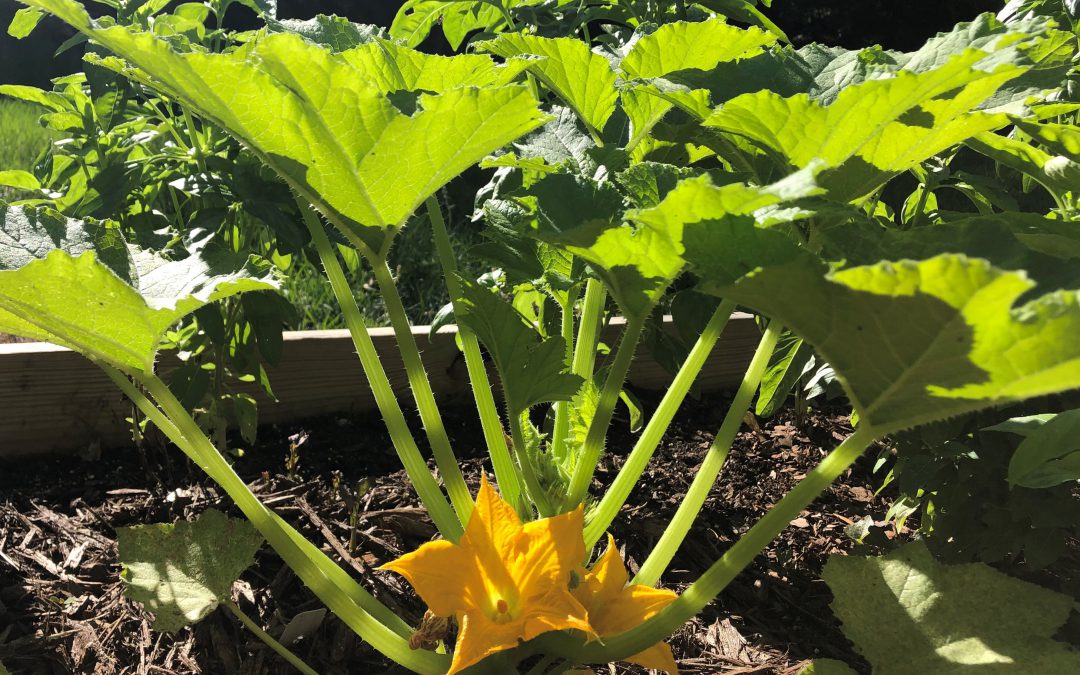
by Molly Jameson | May 7, 2020
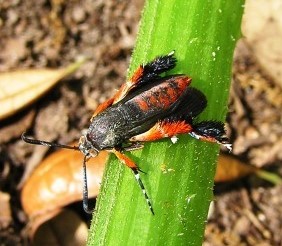
Adult squash vine borer moths are easy to identify, as they are reddish orange and have black dots along their upper abdomen. Photo by Theresa Friday.
It’s been a few weeks, and your squash seedlings are really starting to take off. The days are blushing with summer warmth and the flicker of lightning bugs in the evening indicates the cool nip of spring is winding down. In your garden, this has culminated in lengthening cucurbit stems that now show off a beautiful bright shade of green. Squash blossoms appear overnight and begin to expand and take shape, nestling themselves under the backdrop of slightly darker green squash leaves.
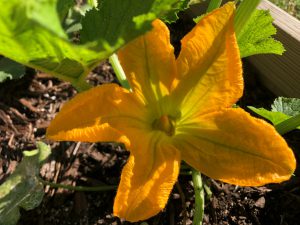
Black beauty zucchini blossom in the morning sun. Photo by Molly Jameson.
A few more nights go by, giving you a chance to explore some recipes. Maybe it’s time to fire up the grill and make grilled summer squash, sprinkled with fresh mint or thyme. Perhaps you’ll make a summer squash pesto pizza. Afterall, your basil is ready for its first harvest. If you are ahead of the game, you might even have some vine-ripening tomatoes that would pair nicely with squash in a creamy pasta sauce.
Your culinary dreams are running wild when you start to notice the wilt. You panic, and think you’ve forgotten to water the garden. But no, you’ve given your garden a consistent dose of water every morning. Your basil looks fine. Your tomatoes look great. What is going on?
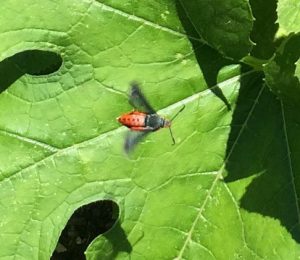
Squash vine borer adult in flight. Photo by Molly Jameson.
You have fallen prey to the dreaded squash vine borer (Melittia cucurbitae).
These garden pests rely strictly on plant species within the genus Cucurbita. If the squash vine borer didn’t wreak such havoc in your summer garden, you might find its striking red and black features fascinating. Unfortunately, if your squash plants are wilting unexpectedly, this daytime roaming moth may have already done its damage.
Adults lay single reddish-brown, millimeter-long eggs on the lower end of the main stem – or on leaves, leaf stalks, fruit buds, or in the soil near the squash plant. Within one to two weeks, larvae hatch, bore into the stem of healthy cucurbits, and begin to chew their way up. Multiple larvae can infect a single plant. This blocks the transport of water and nutrients, leading to the dreadful wilt that often signifies that it is too late.
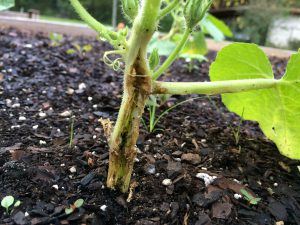
A squash plant severely damaged by squash vine borer larvae. Photo by Molly Jameson.
So, what can be done? Once the wilting has begun, you may be able to reap a small harvest, depending on the timing of infestation. Adult females emerge from cocoons from May to October in Florida and have two generations per season. They prefer cucurbit varieties with large tubular stems, such as yellow squash, zucchini, and pumpkins, but can also infest watermelon and cucumbers.
If you have some cucurbits that do not show signs of infestation but others that are on the decline, it might be worth removing and destroying the infested plants. At the end of the season, cultivate your soil one to two inches deep, as this is where they overwinter in cocoons. Destroying infested plants and cultivation can help reduce the overwintering population.
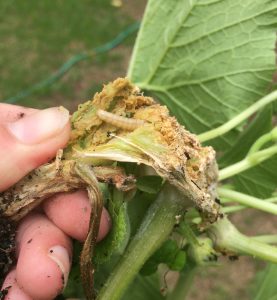
Squash vine borer larvae inside a squash stem. Photo by Molly Jameson.
In North Florida, try seeding squash indoors in March and plant seedlings in the garden in early April. The earlier you plant, the better chance you have of beating the borers. Of course, you must balance the risk of borers with the risk of a late frost.
You may also want to install lightweight floating row covers that can prevent the female from depositing her eggs. But again, it’s a delicate balance, as you do not want to prevent beneficial insects from pollinating your squash once it is producing blossoms.
Scout your plants diligently each day and keep on the lookout for eggs and adults. Adults are attracted to the color yellow, so yellow sticky traps or yellow bowls of water may lure them in. Build up the soil around developing plants to act as a shield against egg laying and boring.
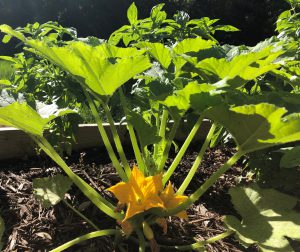
A healthy straightneck squash plant beginning to set fruit. Photo by Molly Jameson.
Once your plants slow their fruit production and you’ve had your fill of grilled squash, squash pizza, and creamy squash pasta, go ahead and remove the plants to prevent late infestations that can then overwinter. Lastly, rotate areas in which you plant cucurbits each year to break borer life cycles.
Vegetable gardening involves innovation and ingenuity. A clever gardener is always striving to balance weather, timing, insects, plants, soil, and everything in between. With a little planning and persistence, I know you can prevail against the tenacious squash vine borer.
For more information about squash vine borers, check out the UF/IFAS EDIS publication, Squash Vine Borer Melittia cucurbitae (https://edis.ifas.ufl.edu/in1068).

by Molly Jameson | Apr 15, 2020
During the COVID-19 crisis, many of us have found that we have more time for activities at home. One activity that can be beneficial to your mental and physical health is gardening. Not only will gardening get you moving physically, but simply being outdoors can help you feel more relaxed during these stressful times. By vegetable gardening, you get the added bonus of becoming more self-sufficient by growing your own healthy food.

You can still gather your gardening supplies at local garden centers during COVID-19. Photo by Brenda Buchan.
To grow vegetables successfully, you will need some basic gardening supplies. This includes seeds or seedlings, fertile soil, gardening tools, and irrigation materials. If you are an avid gardener, you may already have these items at your house. But if you are new to gardening – or if you are simply missing an essential item in your everyday gardening arsenal – where do you go?
Thankfully in Florida, industries regarded as essential during these tough times include food, agriculture, and infrastructure support services. This means farmers, farm workers, farmers’ markets, produce stands, food banks, agribusiness support services, and landscaping services can continue to operate.
But for these essential services to operate safely, they still need to follow social distancing principles to protect the health of both their customers and workers. Therefore, many of our agriculture and horticulture industry personnel are finding ways to adapt. Although this involves making many adjustments, operations such as garden centers and plant nurseries are changing how they function to meet the demand of their customers while remaining safe.
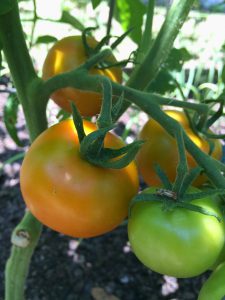
Become more self-sufficient by growing your own healthy food in your backyard. Photo by Molly Jameson.
For example, Native Nurseries in Tallahassee has temporarily closed its doors to the public, but they offer pickup and delivery options that are consistent with social distancing guidelines. Customers can either email or call the nursery and provide their contact and billing information, their purchase requests, and specify either pickup or delivery. Pickup orders are placed in a labeled designated parking space for the customer. For a fee, Native Nurseries also offers delivery of purchased items.
If you plan to make a trip to a garden center or plant nursery, call ahead or check the company’s website to learn about its social distancing policies, pickup and delivery options, and any potentially reduced hours of operation.
By continuing to support our local agriculture and horticulture businesses, we can ensure that they can weather this storm and continue to provide us with their essential services long into the future.
So, gather your supplies, stay home, and get your spring and summer vegetable garden growing!
For more information about essential services in Florida, visit: https://www.floridadisaster.org/.
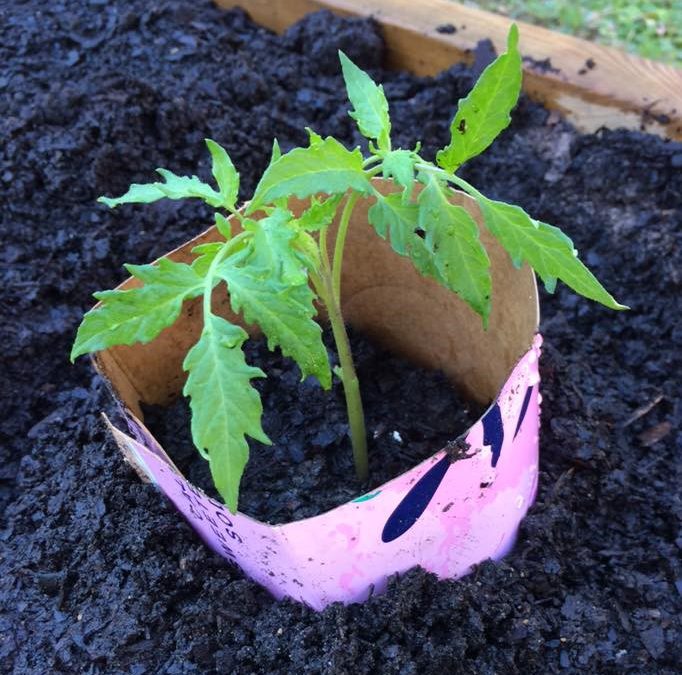
by Molly Jameson | Feb 27, 2020
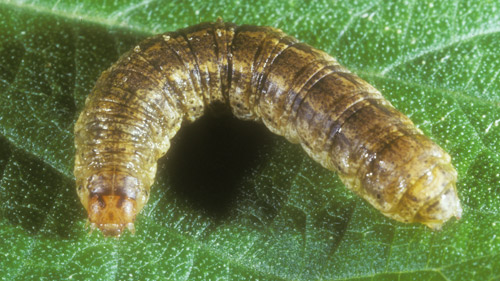
Larva of the granulate cutworm (Feltia subterranea). Photo by John L. Capinera, Entomology and Nematology Department, University of Florida.
One of the biggest predicaments growing vegetables in my backyard garden is dealing with cutworms. Cutworms are a type of nocturnal moth larvae that feed by wrapping themselves around seedling stems at the soil surface. They then cut the stem of the seedling in two – as if Edward Scissorhands dropped by for a visit – killing the plant. There are multiple species, but one of the most common in Florida is the granulate cutworm (Feltia subterranea). They are distributed most frequently in the tropics but can occur as far north as Southern Canada and regularly occur in the Southeastern United States.
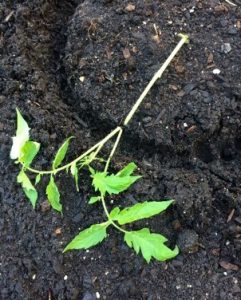
My plan was to install cutworm collars the next morning. But that night, cutworms chewed through the stem of this tomato seedling in two locations. Photo by Molly Jameson.
Since cutworms feed at nighttime it is particularly frustrating, as you will find plants which appeared fine in the evening destroyed by morning. What’s even more frustrating is they feed in multiple seasons on a very wide range of crops, including tomatoes, beans, corn, eggplant, lettuce, peppers, watermelon, celery, broccoli, cabbage, and kale, to name a few. This fall and winter, I even found they had attacked my carrots and onions, which I thought would be more resistant.
One approach a backyard gardener can take in combatting cutworms is to use physical barriers. Netting or row cover can help prevent mature moths from ovipositing their eggs. But if you already have larvae invading, this technique will be ineffective.
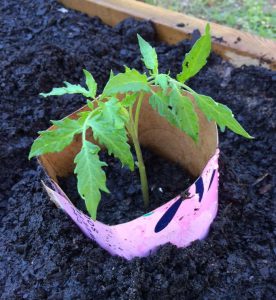
For plants with stems less than pencil-width thick, make cutworm collars to help protect young seedlings from attack. Photo by Molly Jameson.
Plants with stems that are less than pencil-width thick are most susceptible to cutworm damage. A useful tactic is to make what are called “cutworm collars.” Surround individual seedlings with toilet paper rolls, taking care not to break fragile stems as you position the rolls over the plants. Materials such as soda cans or cereal boxes can be cut into strips to encircle seedlings if toilet paper rolls are too small to safely fit over the plant. Try to extend the cardboard two inches below and two inches above the soil surface. In this way, the cardboard acts as a barrier, and can help keep cutworms from accessing the stems.
Unfortunately, if cutworms are already hiding in soil close to the plants, the collars might not be effective. Another technique to try, especially if cutworms are already present, is the toothpick method. Place two toothpicks vertically in the soil on each side of the stem. They should be right up against the stem. In this manner, the toothpicks should prevent the cutworm from wrapping around the stem to chew through.
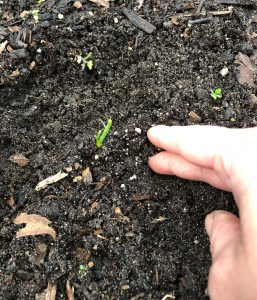
This onion start was given a moonlit haircut by feasting cutworms. If you are lucky, you may be able to find the culprit by digging around the soil adjacent to the afflicted plant. Photo by Molly Jameson.
It can also be helpful to scout your garden for cutworms. Carefully dig one to two inches into the soil near afflicted seedlings. The caterpillars are small, growing from a few millimeters up to less than two inches in length, but tend to stay curled up near the soil surface within about a foot radius of their vegetative victims. Crush any cutworms you find, or for the squeamish, simply drop the cutworms into soapy water.
Applying the bacterial insecticide Bacillus thuringiensis var. kurstaki (Bt for short) may help control cutworms but be sure to apply in the evenings and not before a rainfall or irrigation event, as sunlight and water render Bt useless. And keep in mind, cutworms must digest Bt to be effective, so you may need to apply multiple applications. As with any insecticide, always remember to follow the directions on the label. Once seedling stems grow larger than pencil-width, they should be safe from cutworm mayhem. That is… until the next garden vandal comes along!
To learn more, visit the University of Florida Entomology and Nematology Department’s Featured Creatures page about the granulate cutworm (http://entnemdept.ufl.edu/creatures/veg/granulate_cutworm.htm). You can also search for cutworms on the UF/IFAS EDIS website to learn about additional cutworm species found in our area (http://edis.ifas.ufl.edu/).
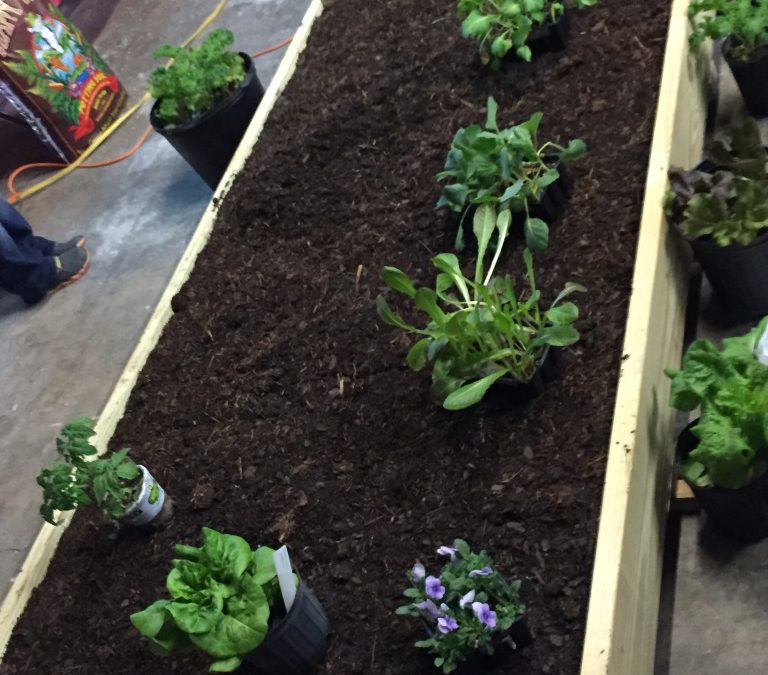
by Molly Jameson | Jan 27, 2020
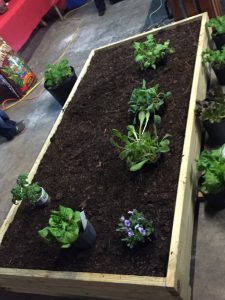
A raised bed container garden , about 8 inches deep. Image Credit Matthew Orwat
Interested in growing vegetable crops but have limited space for a garden bed? Maybe you live in an apartment, have poor soil, or you can’t find a sunny enough location to start an in-ground garden.
The good news is you can grow nearly any crop in a container! Even crops such as beans, squash, watermelon, and sweet potatoes can be grown to maturity and produce high yields if they are grown in properly sized containers with nutritious potting soil.
The Container Gardening: Recommended Varieties and Spacing chart covers the recommended minimum container volume, container depth, plant spacing, and varieties that do well in containers for each crop:

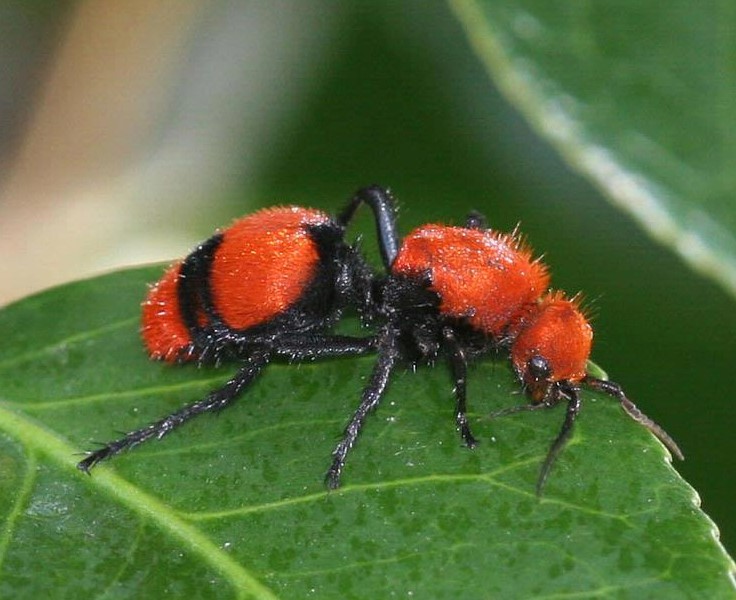
by Molly Jameson | Dec 10, 2019

This velvet ant (Dasymutilla occidentalis) is a female, and therefore has no wings, but it does have a long ovipositor that could inflict a painful sting if provoked. Photo by Johnny N. Dell, Bugwood.org.
The Docile Nature of a Cow Killer
Has a large, flashy, bright red-orange, fuzzy ant-like creature ever captured your attention? It may have been the infamous velvet ant, otherwise fittingly known as “cow killer” for the very painful sting it can inflict. A solitary species that builds no nest of their own, you’d likely only see one at a time, perhaps crawling over bare soil or along a tree root.
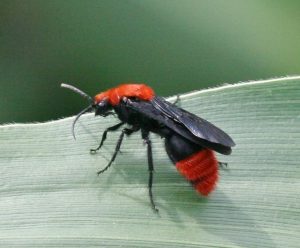
This velvet ant (Dasymutilla occidentalis) is a male, and therefore has wings, but no stinger. Photo by Johnny N. Dell, Bugwood.org.
Velvet ants are actually not ants at all, but wasps. They are wasps that – although capable of stinging humans and other large animals – are not aggressive and have venom with relatively low toxicity (less than that of a honeybee). That said, an accidental sting by the female’s long ovipositor inflicts serious pain that one would not soon forget.
Velvet ants are in the Mutillidae family, which contain about 8,000 species throughout the world. But only fifty Mutillidae species can be found in Florida, as most prefer arid regions, such as the southwest United States.
If you see a velvet ant with wings, rest assured, it is a male. Although capable of flight, males are incapable of stinging, as they lack stingers. Females, who lack wings, need a suitable host to be able to lay their eggs, and they spend most of their time looking for one. They rely mainly on mature larvae (such as pupae and cocoons) of other solitary species in the Hymenoptera order (other wasps, bees, and ants) to parasitize. That is, a female adult velvet ant will forcibly enter a nest to deposit an egg beside its larval victim. When the velvet ant larva emerges, it will consume this host within about a week before it matures and emerges from the host nest to seek a mate.
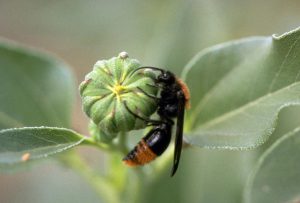
Adult velvet ants feed on flower nectar. Photo by Whitney Cranshaw, Colorado State University, Bugwood.org.
The “velvet” part of velvet ant refers to the dense heap of hairs covering top portions of its body, which is usually a bright shade of red or orange, although some species are gold, silver, black, or white. Velvet ants use their aposematic coloration to their advantage. They tell potential predators “don’t mess with me” through their visually striking, often red and black “stripes,” that act as a visual defense mechanism.
Beyond coloration, a female velvet ant will also produce a warning sound when provoked, further evidence that she wishes to remain docile, rather than fight. Despite their gory parasitism on which they rely to reproduce, adults simply feed on nectar.
So, the next time the mesmerizing bright red streak of a velvet ant catches your gaze, keep your distance, but have no fear, for this cow killer comes in peace.





















